Research Methodology: Wireless Home Security System Development
VerifiedAdded on 2023/06/12
|17
|3693
|404
Report
AI Summary
This assignment focuses on the research methodology for developing a wireless home security system. It begins with a literature review and identifies research problems and sub-problems related to home automation and security. The assignment discusses qualitative and quantitative methodologies, ultimately choosing survey methodology, a quantitative method that allows for both qualitative and quantitative data collection. The report reviews existing methodologies in the context of home security, analyzing selected sub-problems and summarizing relevant literature. Finally, it proposes a methodology, justifying its choice, outlining benefits and limitations, and providing a framework for the study. This assignment is designed to determine a suitable research methodology for a thesis on wireless home security.

Research Methodology Assignment-3 1
Research Methodology Assignment 3
by
Rachid Hamadi
Student ID: 30099999
Research Methodology Assignment 3
by
Rachid Hamadi
Student ID: 30099999
Paraphrase This Document
Need a fresh take? Get an instant paraphrase of this document with our AI Paraphraser
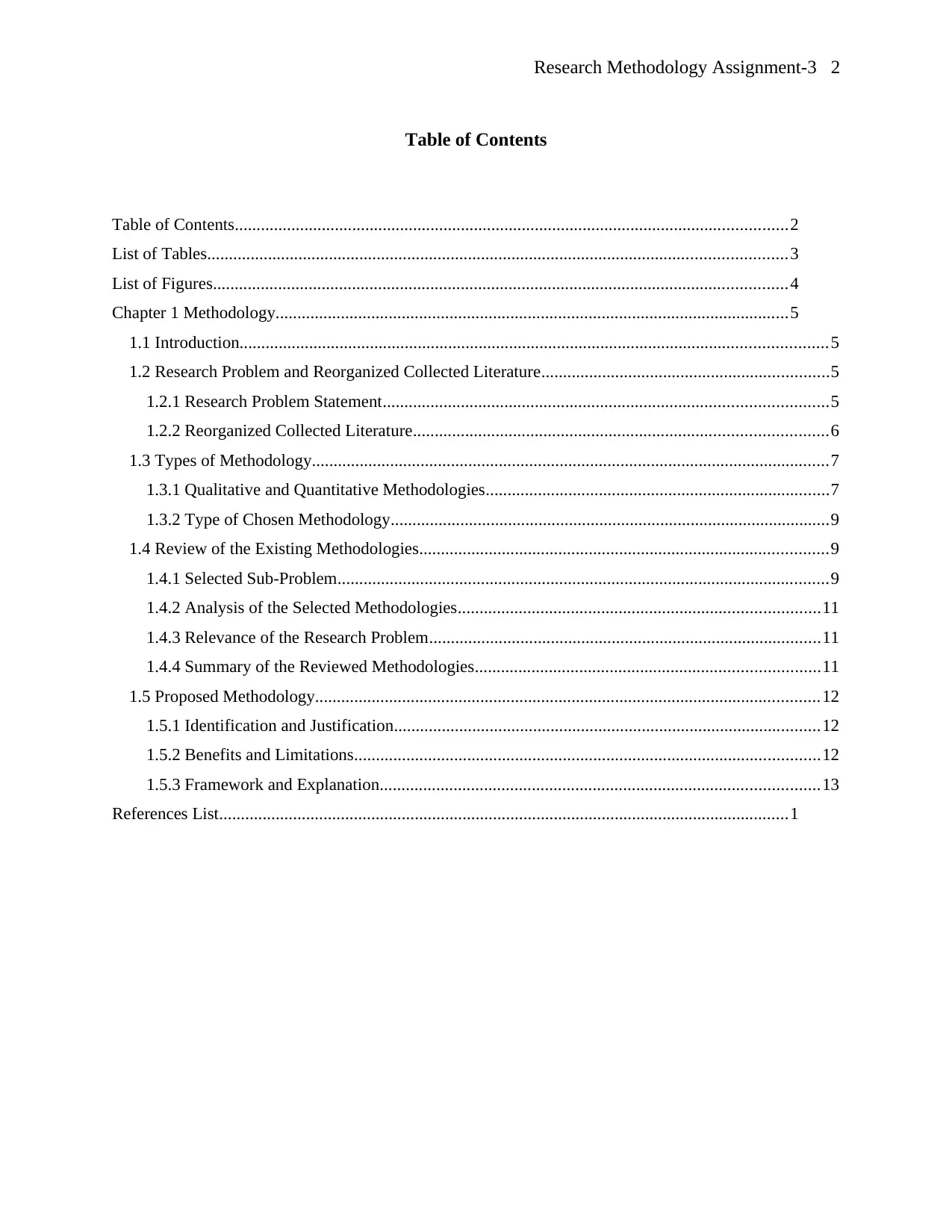
Research Methodology Assignment-3 2
Table of Contents
Table of Contents...............................................................................................................................2
List of Tables.....................................................................................................................................3
List of Figures....................................................................................................................................4
Chapter 1 Methodology......................................................................................................................5
1.1 Introduction.......................................................................................................................................5
1.2 Research Problem and Reorganized Collected Literature..................................................................5
1.2.1 Research Problem Statement......................................................................................................5
1.2.2 Reorganized Collected Literature...............................................................................................6
1.3 Types of Methodology.......................................................................................................................7
1.3.1 Qualitative and Quantitative Methodologies...............................................................................7
1.3.2 Type of Chosen Methodology.....................................................................................................9
1.4 Review of the Existing Methodologies..............................................................................................9
1.4.1 Selected Sub-Problem.................................................................................................................9
1.4.2 Analysis of the Selected Methodologies...................................................................................11
1.4.3 Relevance of the Research Problem..........................................................................................11
1.4.4 Summary of the Reviewed Methodologies...............................................................................11
1.5 Proposed Methodology....................................................................................................................12
1.5.1 Identification and Justification..................................................................................................12
1.5.2 Benefits and Limitations...........................................................................................................12
1.5.3 Framework and Explanation.....................................................................................................13
References List...................................................................................................................................1
Table of Contents
Table of Contents...............................................................................................................................2
List of Tables.....................................................................................................................................3
List of Figures....................................................................................................................................4
Chapter 1 Methodology......................................................................................................................5
1.1 Introduction.......................................................................................................................................5
1.2 Research Problem and Reorganized Collected Literature..................................................................5
1.2.1 Research Problem Statement......................................................................................................5
1.2.2 Reorganized Collected Literature...............................................................................................6
1.3 Types of Methodology.......................................................................................................................7
1.3.1 Qualitative and Quantitative Methodologies...............................................................................7
1.3.2 Type of Chosen Methodology.....................................................................................................9
1.4 Review of the Existing Methodologies..............................................................................................9
1.4.1 Selected Sub-Problem.................................................................................................................9
1.4.2 Analysis of the Selected Methodologies...................................................................................11
1.4.3 Relevance of the Research Problem..........................................................................................11
1.4.4 Summary of the Reviewed Methodologies...............................................................................11
1.5 Proposed Methodology....................................................................................................................12
1.5.1 Identification and Justification..................................................................................................12
1.5.2 Benefits and Limitations...........................................................................................................12
1.5.3 Framework and Explanation.....................................................................................................13
References List...................................................................................................................................1

Research Methodology Assignment-3 3
List of Tables
Table 1: Reorganized Collected Literature.........................................................................7
Table Summary of the Reviewed Methodologies.............................................................10
List of Tables
Table 1: Reorganized Collected Literature.........................................................................7
Table Summary of the Reviewed Methodologies.............................................................10
⊘ This is a preview!⊘
Do you want full access?
Subscribe today to unlock all pages.

Trusted by 1+ million students worldwide

Research Methodology Assignment-3 4
List of Figures
No Figures
List of Figures
No Figures
Paraphrase This Document
Need a fresh take? Get an instant paraphrase of this document with our AI Paraphraser
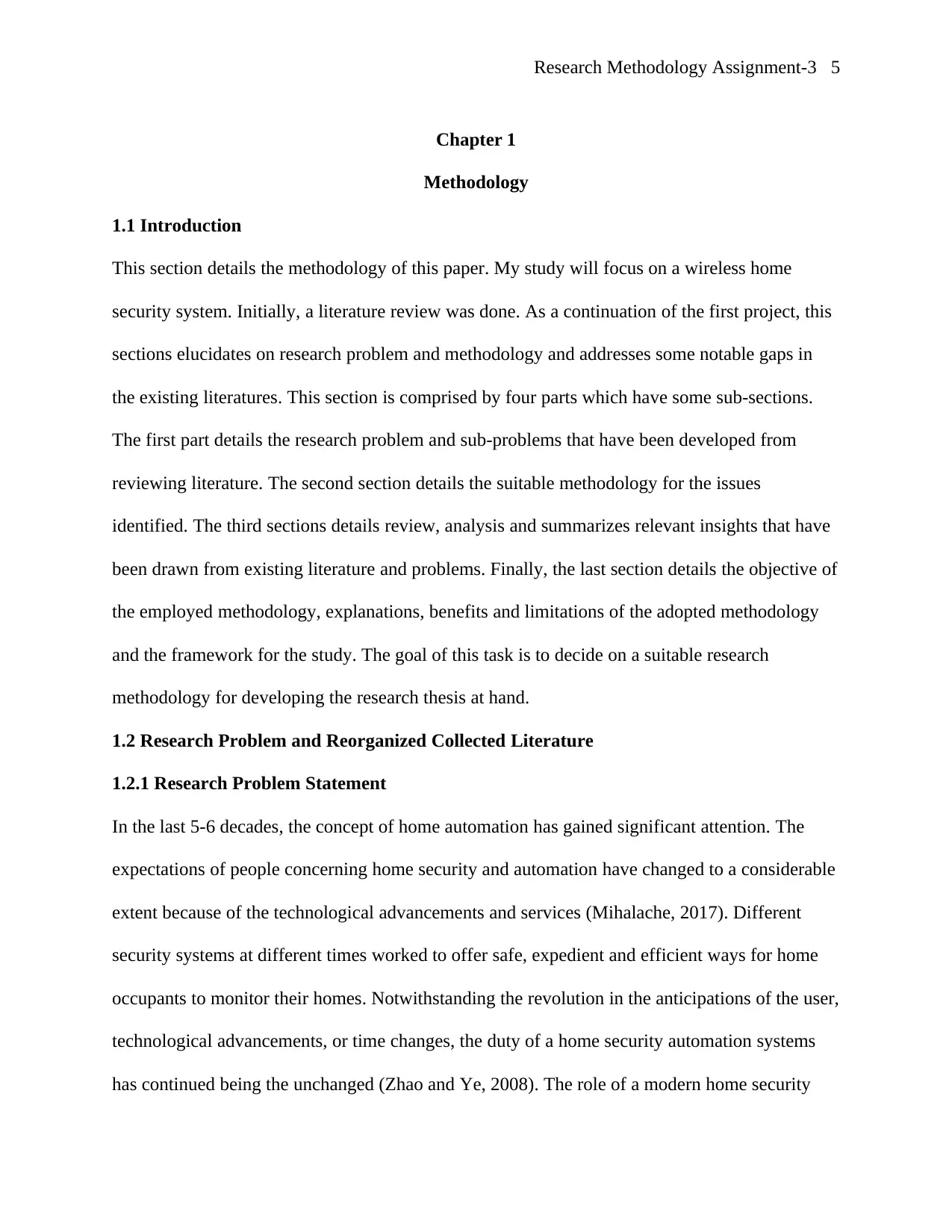
Research Methodology Assignment-3 5
Chapter 1
Methodology
1.1 Introduction
This section details the methodology of this paper. My study will focus on a wireless home
security system. Initially, a literature review was done. As a continuation of the first project, this
sections elucidates on research problem and methodology and addresses some notable gaps in
the existing literatures. This section is comprised by four parts which have some sub-sections.
The first part details the research problem and sub-problems that have been developed from
reviewing literature. The second section details the suitable methodology for the issues
identified. The third sections details review, analysis and summarizes relevant insights that have
been drawn from existing literature and problems. Finally, the last section details the objective of
the employed methodology, explanations, benefits and limitations of the adopted methodology
and the framework for the study. The goal of this task is to decide on a suitable research
methodology for developing the research thesis at hand.
1.2 Research Problem and Reorganized Collected Literature
1.2.1 Research Problem Statement
In the last 5-6 decades, the concept of home automation has gained significant attention. The
expectations of people concerning home security and automation have changed to a considerable
extent because of the technological advancements and services (Mihalache, 2017). Different
security systems at different times worked to offer safe, expedient and efficient ways for home
occupants to monitor their homes. Notwithstanding the revolution in the anticipations of the user,
technological advancements, or time changes, the duty of a home security automation systems
has continued being the unchanged (Zhao and Ye, 2008). The role of a modern home security
Chapter 1
Methodology
1.1 Introduction
This section details the methodology of this paper. My study will focus on a wireless home
security system. Initially, a literature review was done. As a continuation of the first project, this
sections elucidates on research problem and methodology and addresses some notable gaps in
the existing literatures. This section is comprised by four parts which have some sub-sections.
The first part details the research problem and sub-problems that have been developed from
reviewing literature. The second section details the suitable methodology for the issues
identified. The third sections details review, analysis and summarizes relevant insights that have
been drawn from existing literature and problems. Finally, the last section details the objective of
the employed methodology, explanations, benefits and limitations of the adopted methodology
and the framework for the study. The goal of this task is to decide on a suitable research
methodology for developing the research thesis at hand.
1.2 Research Problem and Reorganized Collected Literature
1.2.1 Research Problem Statement
In the last 5-6 decades, the concept of home automation has gained significant attention. The
expectations of people concerning home security and automation have changed to a considerable
extent because of the technological advancements and services (Mihalache, 2017). Different
security systems at different times worked to offer safe, expedient and efficient ways for home
occupants to monitor their homes. Notwithstanding the revolution in the anticipations of the user,
technological advancements, or time changes, the duty of a home security automation systems
has continued being the unchanged (Zhao and Ye, 2008). The role of a modern home security
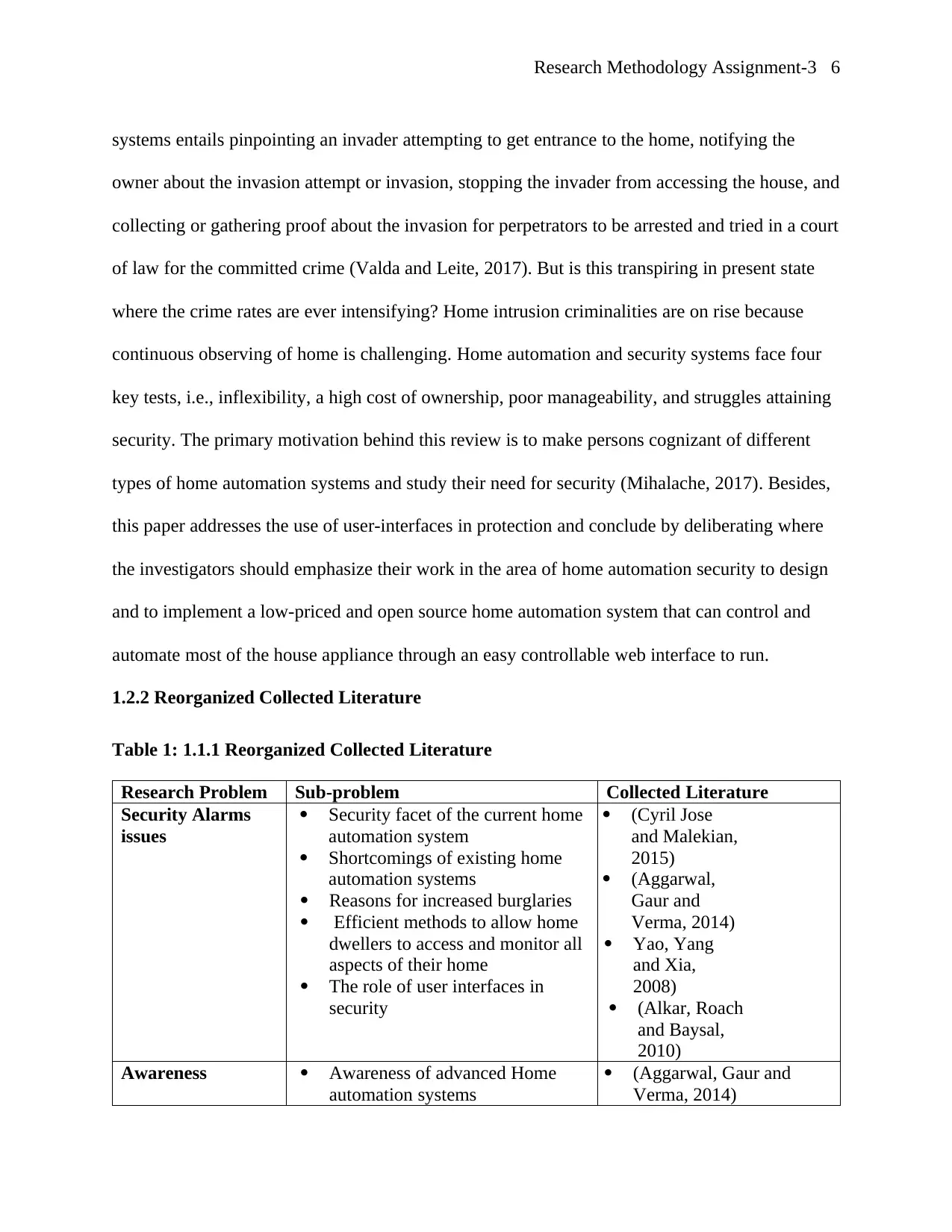
Research Methodology Assignment-3 6
systems entails pinpointing an invader attempting to get entrance to the home, notifying the
owner about the invasion attempt or invasion, stopping the invader from accessing the house, and
collecting or gathering proof about the invasion for perpetrators to be arrested and tried in a court
of law for the committed crime (Valda and Leite, 2017). But is this transpiring in present state
where the crime rates are ever intensifying? Home intrusion criminalities are on rise because
continuous observing of home is challenging. Home automation and security systems face four
key tests, i.e., inflexibility, a high cost of ownership, poor manageability, and struggles attaining
security. The primary motivation behind this review is to make persons cognizant of different
types of home automation systems and study their need for security (Mihalache, 2017). Besides,
this paper addresses the use of user-interfaces in protection and conclude by deliberating where
the investigators should emphasize their work in the area of home automation security to design
and to implement a low-priced and open source home automation system that can control and
automate most of the house appliance through an easy controllable web interface to run.
1.2.2 Reorganized Collected Literature
Table 1: 1.1.1 Reorganized Collected Literature
Research Problem Sub-problem Collected Literature
Security Alarms
issues
Security facet of the current home
automation system
Shortcomings of existing home
automation systems
Reasons for increased burglaries
Efficient methods to allow home
dwellers to access and monitor all
aspects of their home
The role of user interfaces in
security
(Cyril Jose
and Malekian,
2015)
(Aggarwal,
Gaur and
Verma, 2014)
Yao, Yang
and Xia,
2008)
(Alkar, Roach
and Baysal,
2010)
Awareness Awareness of advanced Home
automation systems
(Aggarwal, Gaur and
Verma, 2014)
systems entails pinpointing an invader attempting to get entrance to the home, notifying the
owner about the invasion attempt or invasion, stopping the invader from accessing the house, and
collecting or gathering proof about the invasion for perpetrators to be arrested and tried in a court
of law for the committed crime (Valda and Leite, 2017). But is this transpiring in present state
where the crime rates are ever intensifying? Home intrusion criminalities are on rise because
continuous observing of home is challenging. Home automation and security systems face four
key tests, i.e., inflexibility, a high cost of ownership, poor manageability, and struggles attaining
security. The primary motivation behind this review is to make persons cognizant of different
types of home automation systems and study their need for security (Mihalache, 2017). Besides,
this paper addresses the use of user-interfaces in protection and conclude by deliberating where
the investigators should emphasize their work in the area of home automation security to design
and to implement a low-priced and open source home automation system that can control and
automate most of the house appliance through an easy controllable web interface to run.
1.2.2 Reorganized Collected Literature
Table 1: 1.1.1 Reorganized Collected Literature
Research Problem Sub-problem Collected Literature
Security Alarms
issues
Security facet of the current home
automation system
Shortcomings of existing home
automation systems
Reasons for increased burglaries
Efficient methods to allow home
dwellers to access and monitor all
aspects of their home
The role of user interfaces in
security
(Cyril Jose
and Malekian,
2015)
(Aggarwal,
Gaur and
Verma, 2014)
Yao, Yang
and Xia,
2008)
(Alkar, Roach
and Baysal,
2010)
Awareness Awareness of advanced Home
automation systems
(Aggarwal, Gaur and
Verma, 2014)
⊘ This is a preview!⊘
Do you want full access?
Subscribe today to unlock all pages.

Trusted by 1+ million students worldwide
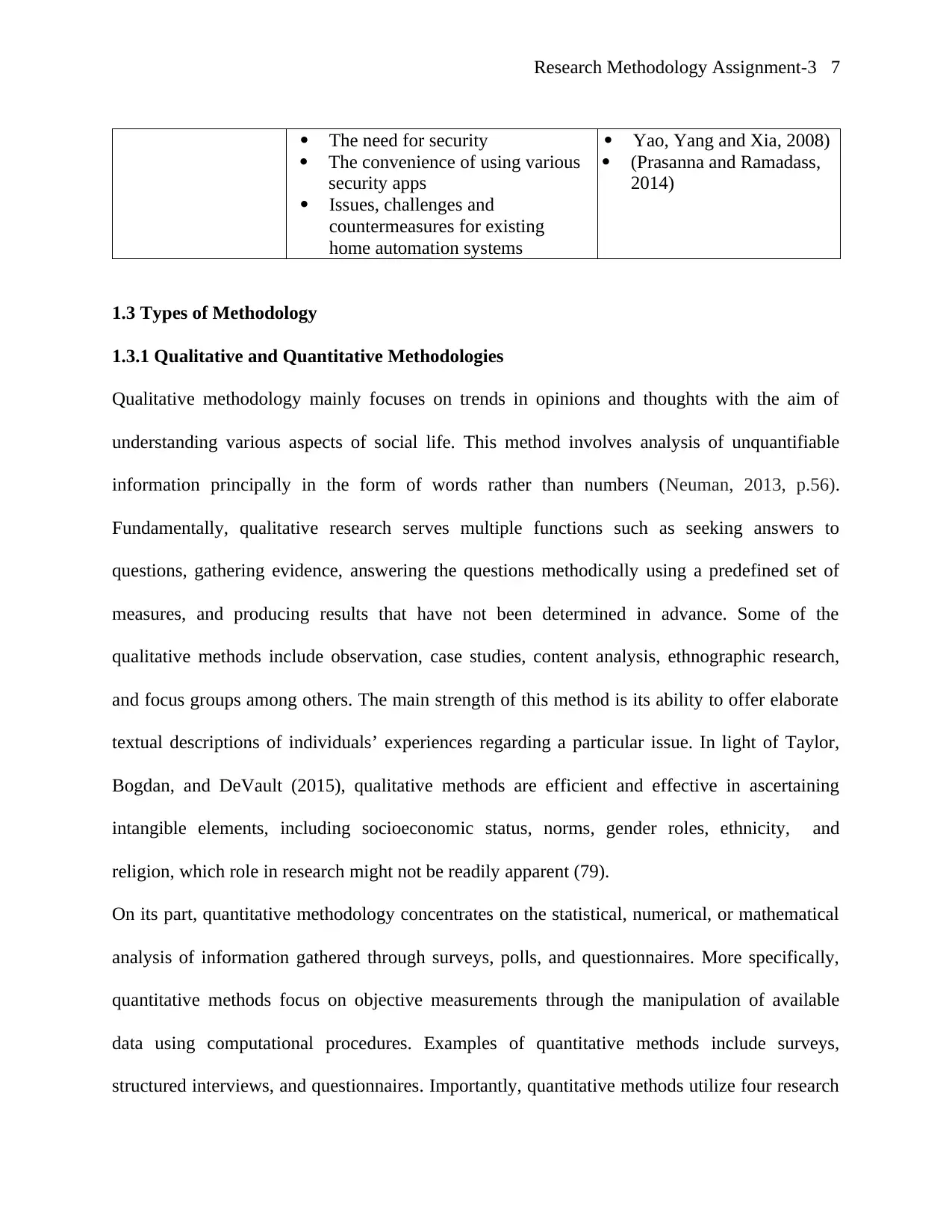
Research Methodology Assignment-3 7
The need for security
The convenience of using various
security apps
Issues, challenges and
countermeasures for existing
home automation systems
Yao, Yang and Xia, 2008)
(Prasanna and Ramadass,
2014)
1.3 Types of Methodology
1.3.1 Qualitative and Quantitative Methodologies
Qualitative methodology mainly focuses on trends in opinions and thoughts with the aim of
understanding various aspects of social life. This method involves analysis of unquantifiable
information principally in the form of words rather than numbers (Neuman, 2013, p.56).
Fundamentally, qualitative research serves multiple functions such as seeking answers to
questions, gathering evidence, answering the questions methodically using a predefined set of
measures, and producing results that have not been determined in advance. Some of the
qualitative methods include observation, case studies, content analysis, ethnographic research,
and focus groups among others. The main strength of this method is its ability to offer elaborate
textual descriptions of individuals’ experiences regarding a particular issue. In light of Taylor,
Bogdan, and DeVault (2015), qualitative methods are efficient and effective in ascertaining
intangible elements, including socioeconomic status, norms, gender roles, ethnicity, and
religion, which role in research might not be readily apparent (79).
On its part, quantitative methodology concentrates on the statistical, numerical, or mathematical
analysis of information gathered through surveys, polls, and questionnaires. More specifically,
quantitative methods focus on objective measurements through the manipulation of available
data using computational procedures. Examples of quantitative methods include surveys,
structured interviews, and questionnaires. Importantly, quantitative methods utilize four research
The need for security
The convenience of using various
security apps
Issues, challenges and
countermeasures for existing
home automation systems
Yao, Yang and Xia, 2008)
(Prasanna and Ramadass,
2014)
1.3 Types of Methodology
1.3.1 Qualitative and Quantitative Methodologies
Qualitative methodology mainly focuses on trends in opinions and thoughts with the aim of
understanding various aspects of social life. This method involves analysis of unquantifiable
information principally in the form of words rather than numbers (Neuman, 2013, p.56).
Fundamentally, qualitative research serves multiple functions such as seeking answers to
questions, gathering evidence, answering the questions methodically using a predefined set of
measures, and producing results that have not been determined in advance. Some of the
qualitative methods include observation, case studies, content analysis, ethnographic research,
and focus groups among others. The main strength of this method is its ability to offer elaborate
textual descriptions of individuals’ experiences regarding a particular issue. In light of Taylor,
Bogdan, and DeVault (2015), qualitative methods are efficient and effective in ascertaining
intangible elements, including socioeconomic status, norms, gender roles, ethnicity, and
religion, which role in research might not be readily apparent (79).
On its part, quantitative methodology concentrates on the statistical, numerical, or mathematical
analysis of information gathered through surveys, polls, and questionnaires. More specifically,
quantitative methods focus on objective measurements through the manipulation of available
data using computational procedures. Examples of quantitative methods include surveys,
structured interviews, and questionnaires. Importantly, quantitative methods utilize four research
Paraphrase This Document
Need a fresh take? Get an instant paraphrase of this document with our AI Paraphraser
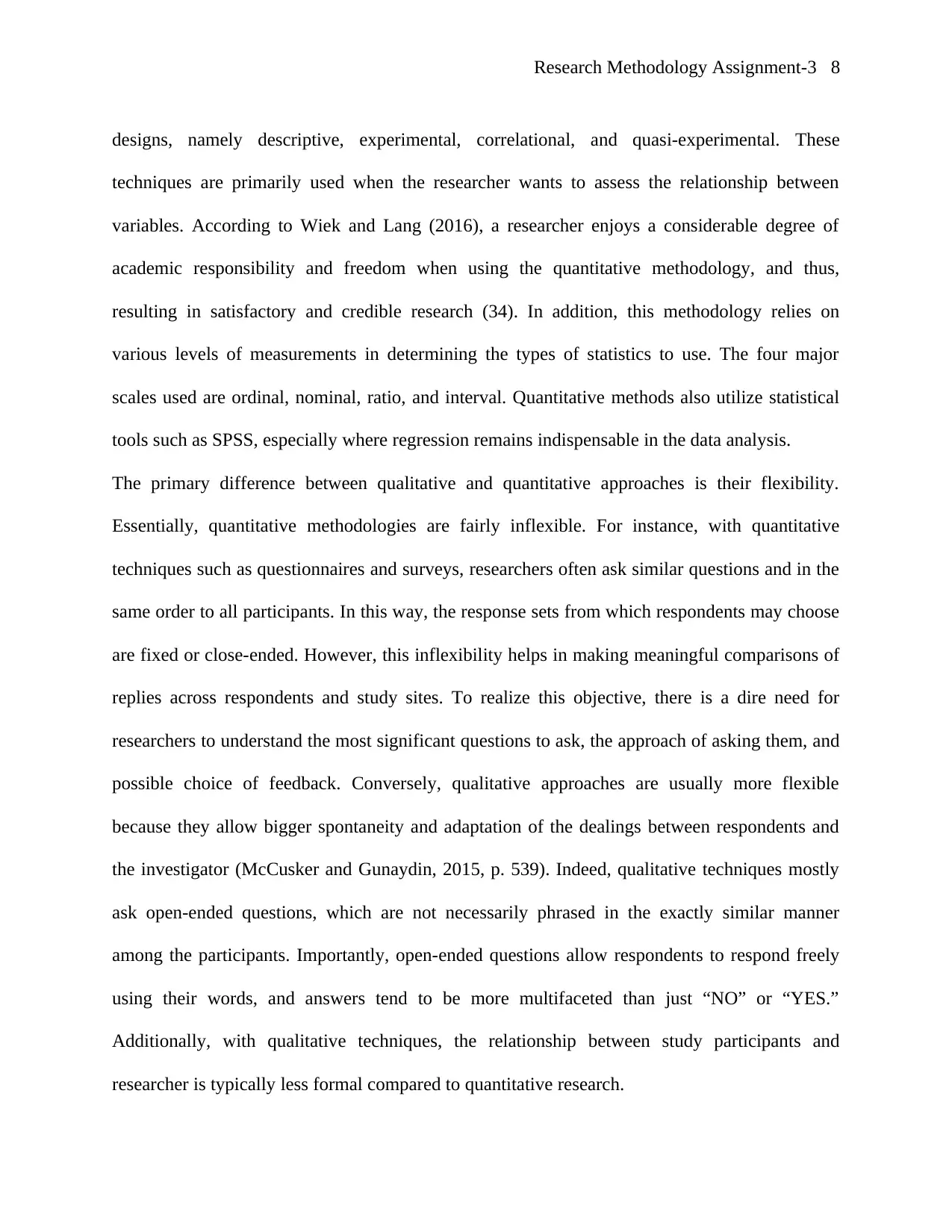
Research Methodology Assignment-3 8
designs, namely descriptive, experimental, correlational, and quasi-experimental. These
techniques are primarily used when the researcher wants to assess the relationship between
variables. According to Wiek and Lang (2016), a researcher enjoys a considerable degree of
academic responsibility and freedom when using the quantitative methodology, and thus,
resulting in satisfactory and credible research (34). In addition, this methodology relies on
various levels of measurements in determining the types of statistics to use. The four major
scales used are ordinal, nominal, ratio, and interval. Quantitative methods also utilize statistical
tools such as SPSS, especially where regression remains indispensable in the data analysis.
The primary difference between qualitative and quantitative approaches is their flexibility.
Essentially, quantitative methodologies are fairly inflexible. For instance, with quantitative
techniques such as questionnaires and surveys, researchers often ask similar questions and in the
same order to all participants. In this way, the response sets from which respondents may choose
are fixed or close-ended. However, this inflexibility helps in making meaningful comparisons of
replies across respondents and study sites. To realize this objective, there is a dire need for
researchers to understand the most significant questions to ask, the approach of asking them, and
possible choice of feedback. Conversely, qualitative approaches are usually more flexible
because they allow bigger spontaneity and adaptation of the dealings between respondents and
the investigator (McCusker and Gunaydin, 2015, p. 539). Indeed, qualitative techniques mostly
ask open-ended questions, which are not necessarily phrased in the exactly similar manner
among the participants. Importantly, open-ended questions allow respondents to respond freely
using their words, and answers tend to be more multifaceted than just “NO” or “YES.”
Additionally, with qualitative techniques, the relationship between study participants and
researcher is typically less formal compared to quantitative research.
designs, namely descriptive, experimental, correlational, and quasi-experimental. These
techniques are primarily used when the researcher wants to assess the relationship between
variables. According to Wiek and Lang (2016), a researcher enjoys a considerable degree of
academic responsibility and freedom when using the quantitative methodology, and thus,
resulting in satisfactory and credible research (34). In addition, this methodology relies on
various levels of measurements in determining the types of statistics to use. The four major
scales used are ordinal, nominal, ratio, and interval. Quantitative methods also utilize statistical
tools such as SPSS, especially where regression remains indispensable in the data analysis.
The primary difference between qualitative and quantitative approaches is their flexibility.
Essentially, quantitative methodologies are fairly inflexible. For instance, with quantitative
techniques such as questionnaires and surveys, researchers often ask similar questions and in the
same order to all participants. In this way, the response sets from which respondents may choose
are fixed or close-ended. However, this inflexibility helps in making meaningful comparisons of
replies across respondents and study sites. To realize this objective, there is a dire need for
researchers to understand the most significant questions to ask, the approach of asking them, and
possible choice of feedback. Conversely, qualitative approaches are usually more flexible
because they allow bigger spontaneity and adaptation of the dealings between respondents and
the investigator (McCusker and Gunaydin, 2015, p. 539). Indeed, qualitative techniques mostly
ask open-ended questions, which are not necessarily phrased in the exactly similar manner
among the participants. Importantly, open-ended questions allow respondents to respond freely
using their words, and answers tend to be more multifaceted than just “NO” or “YES.”
Additionally, with qualitative techniques, the relationship between study participants and
researcher is typically less formal compared to quantitative research.
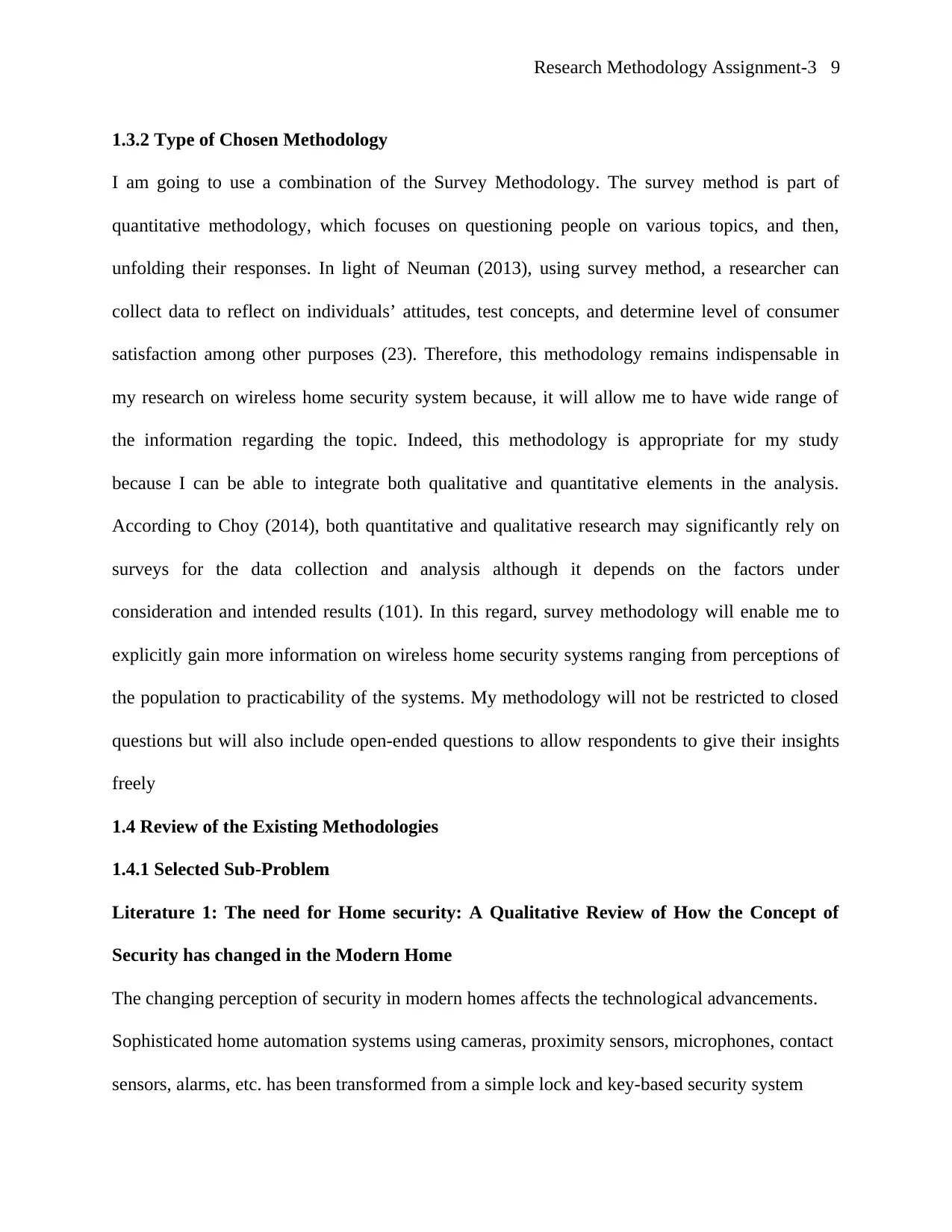
Research Methodology Assignment-3 9
1.3.2 Type of Chosen Methodology
I am going to use a combination of the Survey Methodology. The survey method is part of
quantitative methodology, which focuses on questioning people on various topics, and then,
unfolding their responses. In light of Neuman (2013), using survey method, a researcher can
collect data to reflect on individuals’ attitudes, test concepts, and determine level of consumer
satisfaction among other purposes (23). Therefore, this methodology remains indispensable in
my research on wireless home security system because, it will allow me to have wide range of
the information regarding the topic. Indeed, this methodology is appropriate for my study
because I can be able to integrate both qualitative and quantitative elements in the analysis.
According to Choy (2014), both quantitative and qualitative research may significantly rely on
surveys for the data collection and analysis although it depends on the factors under
consideration and intended results (101). In this regard, survey methodology will enable me to
explicitly gain more information on wireless home security systems ranging from perceptions of
the population to practicability of the systems. My methodology will not be restricted to closed
questions but will also include open-ended questions to allow respondents to give their insights
freely
1.4 Review of the Existing Methodologies
1.4.1 Selected Sub-Problem
Literature 1: The need for Home security: A Qualitative Review of How the Concept of
Security has changed in the Modern Home
The changing perception of security in modern homes affects the technological advancements.
Sophisticated home automation systems using cameras, proximity sensors, microphones, contact
sensors, alarms, etc. has been transformed from a simple lock and key-based security system
1.3.2 Type of Chosen Methodology
I am going to use a combination of the Survey Methodology. The survey method is part of
quantitative methodology, which focuses on questioning people on various topics, and then,
unfolding their responses. In light of Neuman (2013), using survey method, a researcher can
collect data to reflect on individuals’ attitudes, test concepts, and determine level of consumer
satisfaction among other purposes (23). Therefore, this methodology remains indispensable in
my research on wireless home security system because, it will allow me to have wide range of
the information regarding the topic. Indeed, this methodology is appropriate for my study
because I can be able to integrate both qualitative and quantitative elements in the analysis.
According to Choy (2014), both quantitative and qualitative research may significantly rely on
surveys for the data collection and analysis although it depends on the factors under
consideration and intended results (101). In this regard, survey methodology will enable me to
explicitly gain more information on wireless home security systems ranging from perceptions of
the population to practicability of the systems. My methodology will not be restricted to closed
questions but will also include open-ended questions to allow respondents to give their insights
freely
1.4 Review of the Existing Methodologies
1.4.1 Selected Sub-Problem
Literature 1: The need for Home security: A Qualitative Review of How the Concept of
Security has changed in the Modern Home
The changing perception of security in modern homes affects the technological advancements.
Sophisticated home automation systems using cameras, proximity sensors, microphones, contact
sensors, alarms, etc. has been transformed from a simple lock and key-based security system
⊘ This is a preview!⊘
Do you want full access?
Subscribe today to unlock all pages.

Trusted by 1+ million students worldwide
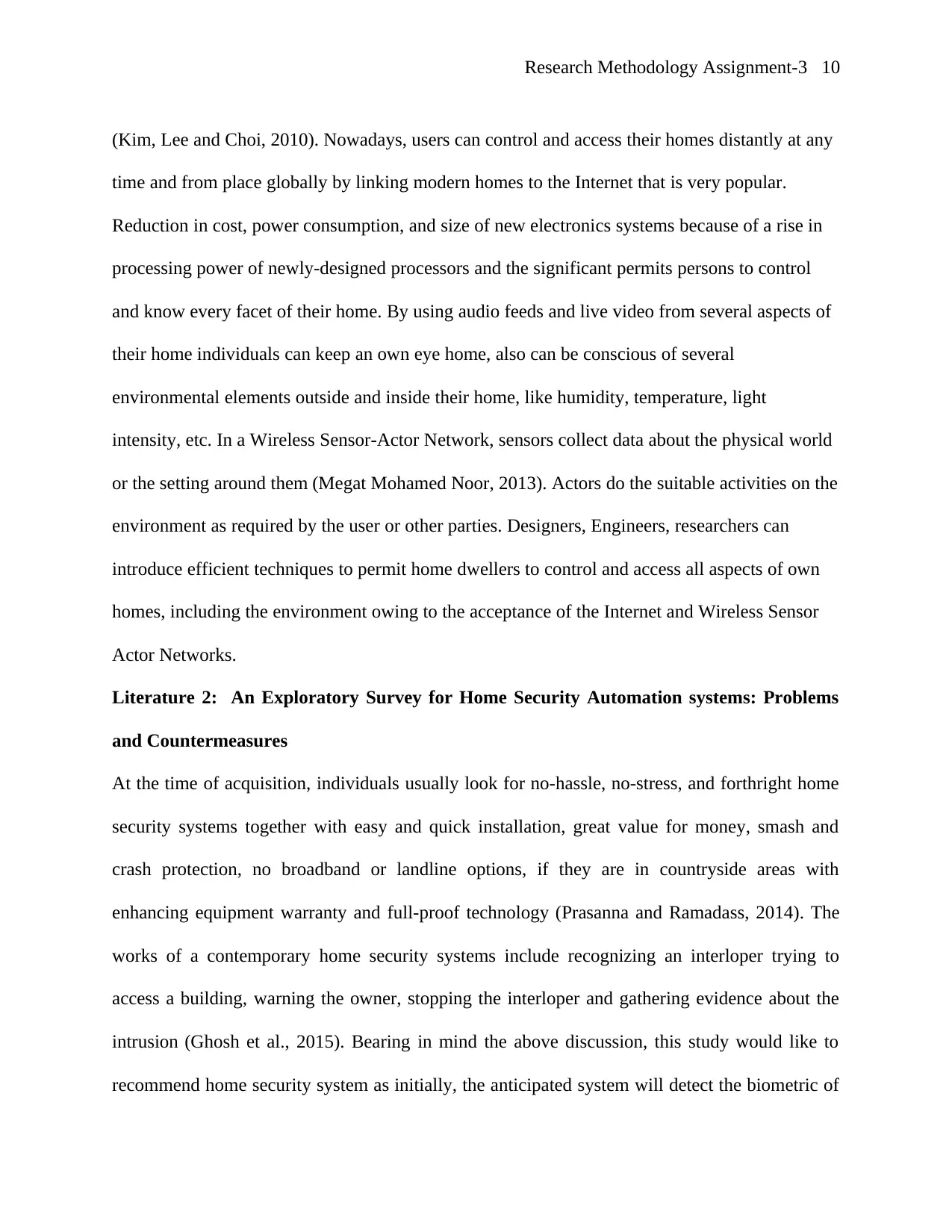
Research Methodology Assignment-3 10
(Kim, Lee and Choi, 2010). Nowadays, users can control and access their homes distantly at any
time and from place globally by linking modern homes to the Internet that is very popular.
Reduction in cost, power consumption, and size of new electronics systems because of a rise in
processing power of newly-designed processors and the significant permits persons to control
and know every facet of their home. By using audio feeds and live video from several aspects of
their home individuals can keep an own eye home, also can be conscious of several
environmental elements outside and inside their home, like humidity, temperature, light
intensity, etc. In a Wireless Sensor-Actor Network, sensors collect data about the physical world
or the setting around them (Megat Mohamed Noor, 2013). Actors do the suitable activities on the
environment as required by the user or other parties. Designers, Engineers, researchers can
introduce efficient techniques to permit home dwellers to control and access all aspects of own
homes, including the environment owing to the acceptance of the Internet and Wireless Sensor
Actor Networks.
Literature 2: An Exploratory Survey for Home Security Automation systems: Problems
and Countermeasures
At the time of acquisition, individuals usually look for no-hassle, no-stress, and forthright home
security systems together with easy and quick installation, great value for money, smash and
crash protection, no broadband or landline options, if they are in countryside areas with
enhancing equipment warranty and full-proof technology (Prasanna and Ramadass, 2014). The
works of a contemporary home security systems include recognizing an interloper trying to
access a building, warning the owner, stopping the interloper and gathering evidence about the
intrusion (Ghosh et al., 2015). Bearing in mind the above discussion, this study would like to
recommend home security system as initially, the anticipated system will detect the biometric of
(Kim, Lee and Choi, 2010). Nowadays, users can control and access their homes distantly at any
time and from place globally by linking modern homes to the Internet that is very popular.
Reduction in cost, power consumption, and size of new electronics systems because of a rise in
processing power of newly-designed processors and the significant permits persons to control
and know every facet of their home. By using audio feeds and live video from several aspects of
their home individuals can keep an own eye home, also can be conscious of several
environmental elements outside and inside their home, like humidity, temperature, light
intensity, etc. In a Wireless Sensor-Actor Network, sensors collect data about the physical world
or the setting around them (Megat Mohamed Noor, 2013). Actors do the suitable activities on the
environment as required by the user or other parties. Designers, Engineers, researchers can
introduce efficient techniques to permit home dwellers to control and access all aspects of own
homes, including the environment owing to the acceptance of the Internet and Wireless Sensor
Actor Networks.
Literature 2: An Exploratory Survey for Home Security Automation systems: Problems
and Countermeasures
At the time of acquisition, individuals usually look for no-hassle, no-stress, and forthright home
security systems together with easy and quick installation, great value for money, smash and
crash protection, no broadband or landline options, if they are in countryside areas with
enhancing equipment warranty and full-proof technology (Prasanna and Ramadass, 2014). The
works of a contemporary home security systems include recognizing an interloper trying to
access a building, warning the owner, stopping the interloper and gathering evidence about the
intrusion (Ghosh et al., 2015). Bearing in mind the above discussion, this study would like to
recommend home security system as initially, the anticipated system will detect the biometric of
Paraphrase This Document
Need a fresh take? Get an instant paraphrase of this document with our AI Paraphraser
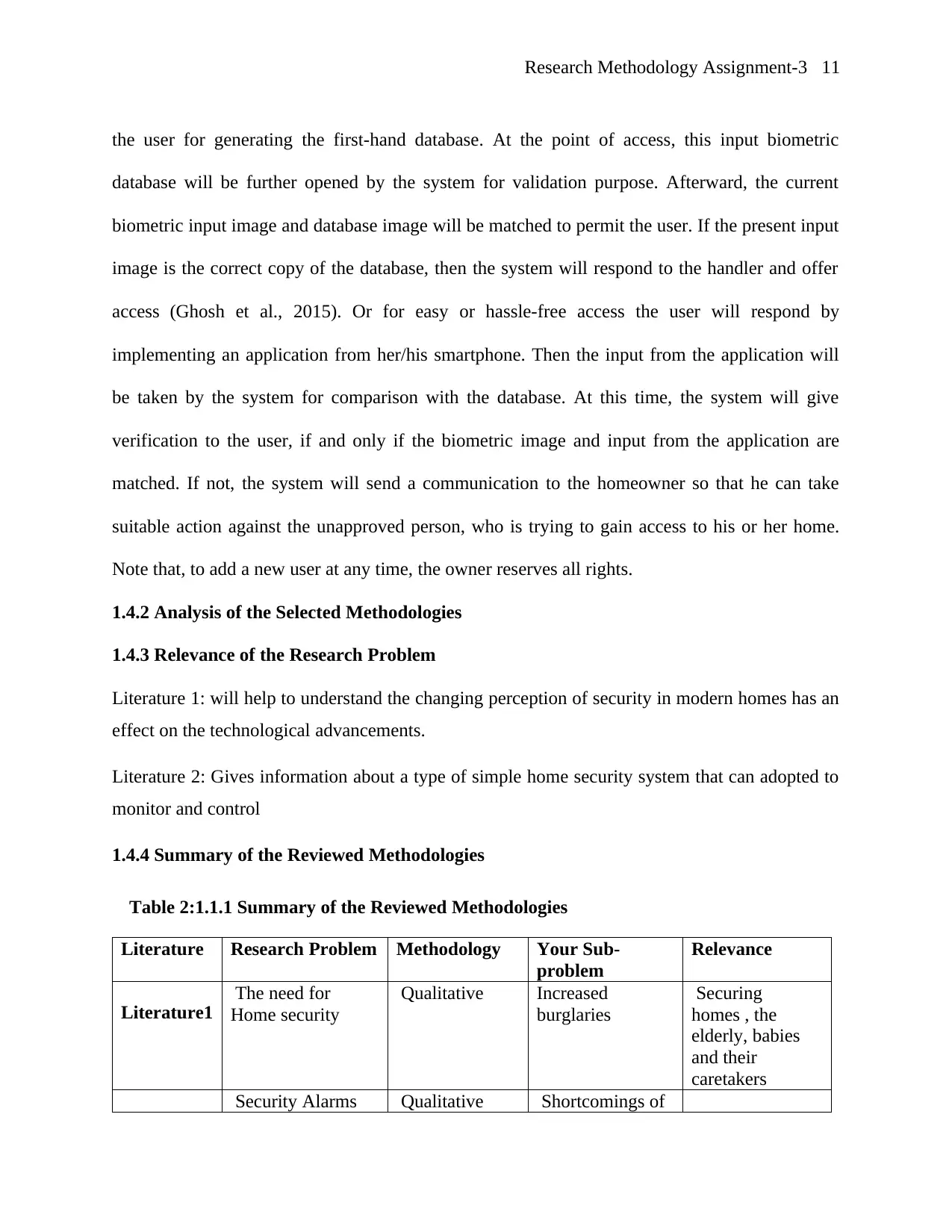
Research Methodology Assignment-3 11
the user for generating the first-hand database. At the point of access, this input biometric
database will be further opened by the system for validation purpose. Afterward, the current
biometric input image and database image will be matched to permit the user. If the present input
image is the correct copy of the database, then the system will respond to the handler and offer
access (Ghosh et al., 2015). Or for easy or hassle-free access the user will respond by
implementing an application from her/his smartphone. Then the input from the application will
be taken by the system for comparison with the database. At this time, the system will give
verification to the user, if and only if the biometric image and input from the application are
matched. If not, the system will send a communication to the homeowner so that he can take
suitable action against the unapproved person, who is trying to gain access to his or her home.
Note that, to add a new user at any time, the owner reserves all rights.
1.4.2 Analysis of the Selected Methodologies
1.4.3 Relevance of the Research Problem
Literature 1: will help to understand the changing perception of security in modern homes has an
effect on the technological advancements.
Literature 2: Gives information about a type of simple home security system that can adopted to
monitor and control
1.4.4 Summary of the Reviewed Methodologies
Table 2:1.1.1 Summary of the Reviewed Methodologies
Literature Research Problem Methodology Your Sub-
problem
Relevance
Literature1
The need for
Home security
Qualitative Increased
burglaries
Securing
homes , the
elderly, babies
and their
caretakers
Security Alarms Qualitative Shortcomings of
the user for generating the first-hand database. At the point of access, this input biometric
database will be further opened by the system for validation purpose. Afterward, the current
biometric input image and database image will be matched to permit the user. If the present input
image is the correct copy of the database, then the system will respond to the handler and offer
access (Ghosh et al., 2015). Or for easy or hassle-free access the user will respond by
implementing an application from her/his smartphone. Then the input from the application will
be taken by the system for comparison with the database. At this time, the system will give
verification to the user, if and only if the biometric image and input from the application are
matched. If not, the system will send a communication to the homeowner so that he can take
suitable action against the unapproved person, who is trying to gain access to his or her home.
Note that, to add a new user at any time, the owner reserves all rights.
1.4.2 Analysis of the Selected Methodologies
1.4.3 Relevance of the Research Problem
Literature 1: will help to understand the changing perception of security in modern homes has an
effect on the technological advancements.
Literature 2: Gives information about a type of simple home security system that can adopted to
monitor and control
1.4.4 Summary of the Reviewed Methodologies
Table 2:1.1.1 Summary of the Reviewed Methodologies
Literature Research Problem Methodology Your Sub-
problem
Relevance
Literature1
The need for
Home security
Qualitative Increased
burglaries
Securing
homes , the
elderly, babies
and their
caretakers
Security Alarms Qualitative Shortcomings of
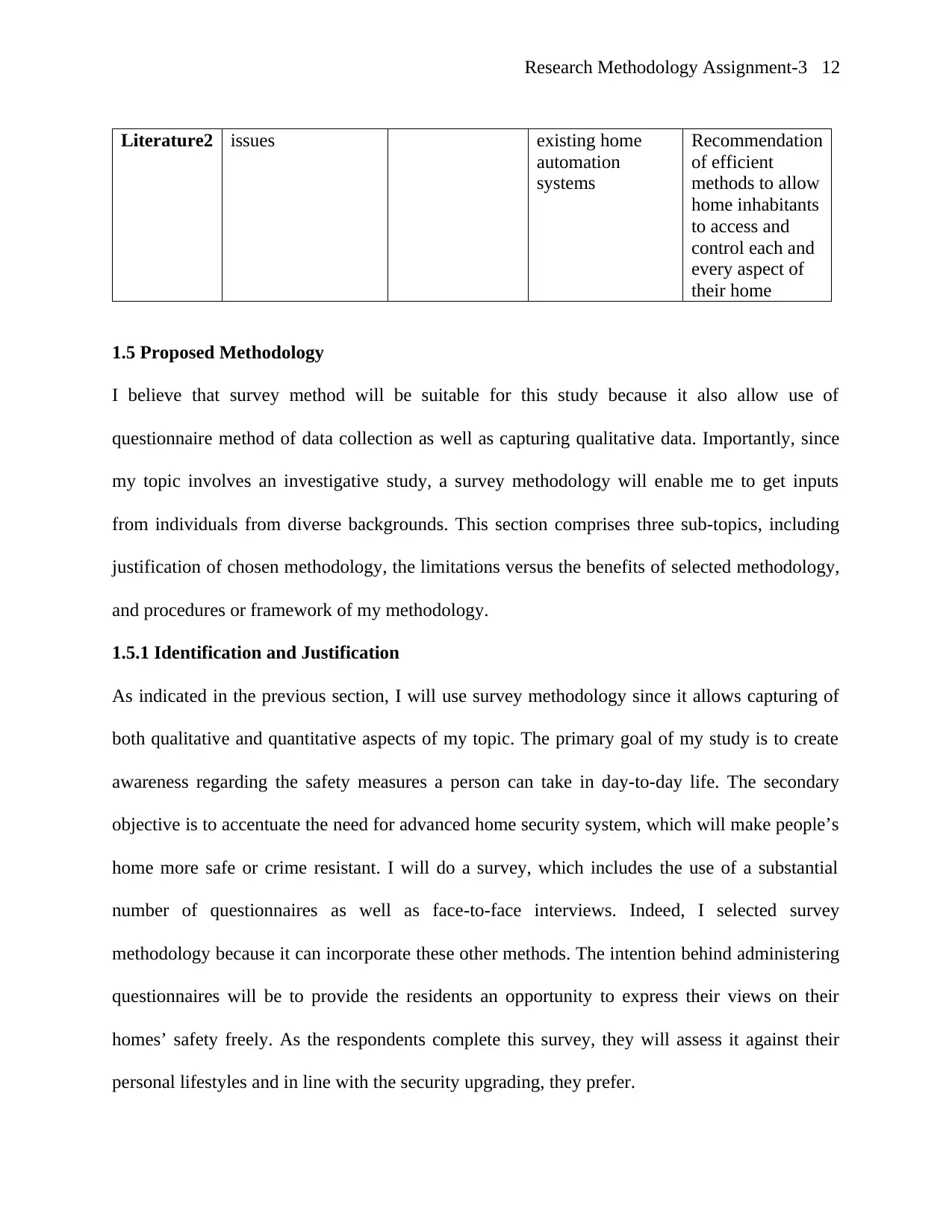
Research Methodology Assignment-3 12
Literature2 issues existing home
automation
systems
Recommendation
of efficient
methods to allow
home inhabitants
to access and
control each and
every aspect of
their home
1.5 Proposed Methodology
I believe that survey method will be suitable for this study because it also allow use of
questionnaire method of data collection as well as capturing qualitative data. Importantly, since
my topic involves an investigative study, a survey methodology will enable me to get inputs
from individuals from diverse backgrounds. This section comprises three sub-topics, including
justification of chosen methodology, the limitations versus the benefits of selected methodology,
and procedures or framework of my methodology.
1.5.1 Identification and Justification
As indicated in the previous section, I will use survey methodology since it allows capturing of
both qualitative and quantitative aspects of my topic. The primary goal of my study is to create
awareness regarding the safety measures a person can take in day-to-day life. The secondary
objective is to accentuate the need for advanced home security system, which will make people’s
home more safe or crime resistant. I will do a survey, which includes the use of a substantial
number of questionnaires as well as face-to-face interviews. Indeed, I selected survey
methodology because it can incorporate these other methods. The intention behind administering
questionnaires will be to provide the residents an opportunity to express their views on their
homes’ safety freely. As the respondents complete this survey, they will assess it against their
personal lifestyles and in line with the security upgrading, they prefer.
Literature2 issues existing home
automation
systems
Recommendation
of efficient
methods to allow
home inhabitants
to access and
control each and
every aspect of
their home
1.5 Proposed Methodology
I believe that survey method will be suitable for this study because it also allow use of
questionnaire method of data collection as well as capturing qualitative data. Importantly, since
my topic involves an investigative study, a survey methodology will enable me to get inputs
from individuals from diverse backgrounds. This section comprises three sub-topics, including
justification of chosen methodology, the limitations versus the benefits of selected methodology,
and procedures or framework of my methodology.
1.5.1 Identification and Justification
As indicated in the previous section, I will use survey methodology since it allows capturing of
both qualitative and quantitative aspects of my topic. The primary goal of my study is to create
awareness regarding the safety measures a person can take in day-to-day life. The secondary
objective is to accentuate the need for advanced home security system, which will make people’s
home more safe or crime resistant. I will do a survey, which includes the use of a substantial
number of questionnaires as well as face-to-face interviews. Indeed, I selected survey
methodology because it can incorporate these other methods. The intention behind administering
questionnaires will be to provide the residents an opportunity to express their views on their
homes’ safety freely. As the respondents complete this survey, they will assess it against their
personal lifestyles and in line with the security upgrading, they prefer.
⊘ This is a preview!⊘
Do you want full access?
Subscribe today to unlock all pages.

Trusted by 1+ million students worldwide
1 out of 17
Related Documents
Your All-in-One AI-Powered Toolkit for Academic Success.
+13062052269
info@desklib.com
Available 24*7 on WhatsApp / Email
![[object Object]](/_next/static/media/star-bottom.7253800d.svg)
Unlock your academic potential
Copyright © 2020–2025 A2Z Services. All Rights Reserved. Developed and managed by ZUCOL.





